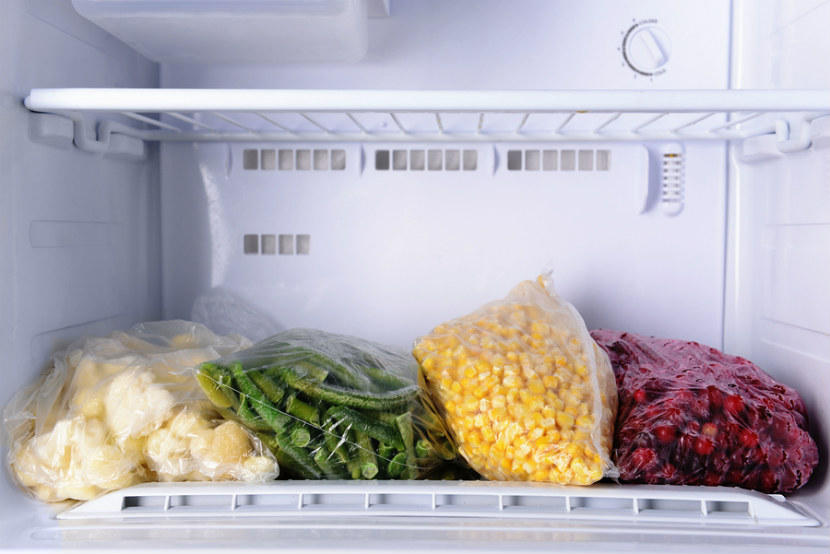
Thaw, reheat and eat. What could be easier! Doubling up a casserole recipe doesn’t take much more time than making just one plus it can be lower in fat, calories and salt and less expensive than a store bought frozen dinner in a box.
Whether you’re freezing delicious homemade cabbage rolls or carrot bran muffins, you’ll save time and get a welcome break from cooking during the week. Make the most of your efforts by freezing foods right and keeping them safe to eat.
What can I freeze and for how long?
For best quality and taste, use the shorter storage times listed.
|
Food |
Freeze it for no longer than… |
|
Leftovers - meat and vegetables |
2-3 months |
|
Soups |
4 months |
|
Most vegetables and fruit (except potatoes, lettuce, radishes, green onions, celery and tomatoes) |
12 months |
|
Breads |
2 months |
|
Milk |
6 weeks |
|
Ground meat |
2-3 months |
|
Beef, roast or steaks |
10-12 months |
|
Chicken pieces |
6 months |
|
Fatty fish (salmon) |
2 months |
Want to know more? Use this handy storage chart from Health Canada.
Tip: For tastier frozen food and to keep food safe to eat, freeze leftovers, and freshly prepared casseroles, soups and sauces right away. Food left on the counter to cool are a food safety risk.
Tip: There is little difference in the nutritional value of fresh or plain frozen food including vegetables and fruit. In addition to purchasing frozen vegetable and fruit, if your grocery store or market has a really good sale on fresh produce, purchase extra to freeze and enjoy at a later date.
Is food that has been frozen for a long time safe to eat?
Food kept at -18ºC (0ºF) will be safe if stored within a reasonable time. Use the Canadian Partnership for Consumer Food Safety Education storage chart to find out how long food will keep.
The taste and texture of frozen foods can suffer from lengthy freezing times. Once thawed, treat frozen food like fresh food that can spoil.
Tip: It’s OK to freeze leftovers, just don’t refreeze them. Instead freeze leftovers in smaller portions so you can take out what you need.
Five freezer friendly tips
Enjoy better tasting frozen food that is safe to eat. Try to:
-
Cool first then freeze. Cool cooked food quickly in the fridge in shallow dishes.
-
Avoid freezer burn. Use heavy foil, freezer bags or containers designed for freezing food. Leave just a few centimeters room for expansion with liquids. Squeeze the air out of freezer bags before sealing or wrap foods tightly in foil.
-
Divide up big batches. Freeze 4-6 portions or less in one freezer bag or container and label it with a “use by” date.
-
Freeze it right at -18ºC (0ºF). Use a thermometer to check the temperature. Leave some space between packages for cool air to circulate. Avoid overloading your freezer.
-
First in first out. Use up the oldest items first.
Tip: Use a wipe on, wipe off board to jot down what goes in and wipe off what goes out of the freezer. Attach the board to the freezer with a magnet.
Top freezer foods
Looking for some ideas for stocking your freezer? Here are some quick tips:
-
Make and freeze extra pancakes. Spread on some peanut butter and top with sliced banana for breakfast or a snack to go.
-
Homemade whole grain muffins. Enjoy as a snack on the way to the gym.
-
Cooked lean ground beef. Divide up a big batch to use later in chili, spaghetti sauce, bean burritos, cabbage rolls or samosas.
-
Berries and bananas. Use in smoothies, mix into yogurt or bake into muffins. Try other frozen fruits too.
-
Plain frozen vegetables. Choose ones with little or no added salt or freeze your own. Toss a handful into your omelets, canned soups and casseroles.
-
Versatile chicken. Think soups, sandwiches, pizza topping, stir fry, quesadillas and more. Cut a whole chicken into pieces. It will freeze and defrost faster, plus it’s often less expensive than buying individual pieces. You can also cut up and freeze cooked chicken to use later in salads and pasta dishes.
-
Make your own chicken broth. It’ll taste better than store bought versions and will probably contain less sodium. Freeze in ice cubes trays then place in a freezer bag for convenient use later.
-
Whole grain pita bread, wraps and pizza crusts. Use for pita pizzas, quesadillas, burritos, breakfast and sandwich wraps.
-
Frozen fish and seafood. Try: cooked shrimp, sole, perch, halibut and haddock.
Tip: Wondering how great a mixed dish will taste after freezing? Try freezing only a small portion to test the taste and quality.
How do you defrost food safely?
Never thaw food at room temperature. Instead use:
-
The fridge - use food within 3 days once thawed.
-
A microwave - then cook it right away.
-
Cold water - fill the sink and change the water every 45 minutes.
Tip: Thawed food should not be re-frozen. Cook it instead and then re-freeze.
Find out more:
Food safety facts on leftovers, by the Canadian Food Inspection Agency
Food safety after a power outage, Nova Scotia Department of Agriculture
Food safety, by Health Canada
Last Update – August 16, 2018